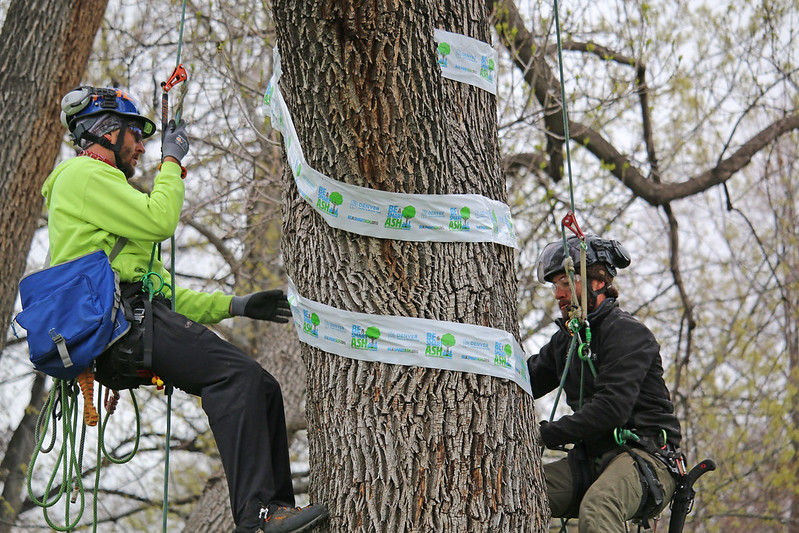In mid-June, the City of Denver confirmed the presence of the emerald ash borer (EAB)…

Help the Office of the City Forester Protect and Diversify Our Urban Forest: Become a Smart Ash
By Office of the City Forester Operations Assistant Lexi Brewer

Background
The Emerald Ash Borer (EAB) is an invasive insect first discovered in the United States near Detroit in 2002.
It’s believed that EAB likely arrived in the United States on lumber in cargo ships originating from its native Asia. It has killed hundreds of millions of ash trees in North America and has been discovered in over 35 states, including Colorado. In fact, it’s been found in surrounding metro areas including Boulder and Arvada, so it’s just a matter of time before it is discovered in Denver. All ash trees that are infested with EAB eventually die because the larvae feed under the bark of ash trees, disrupting the tree’s ability to transport water and nutrients. Because of this, the dieback of the tree is a slow process, starting at the top of the tree. Since one in six of Denver’s trees are ash, Denver’s Office of the City Forester has been proactively preparing and planning for the EAB’s inevitable arrival for more than five years through planting, tree removal and replacement, and treatment activities.

Be A Smart Ash Program
With guidance from management practices such as “Slow Ash Mortality” and experiences learned from states like Michigan that have battled EAB for nearly 15 years, the Office of the City Forester created the Be A Smart Ash program in 2016 to drive awareness and inspire the community to take action to protect the ash trees on their property. Depending on the condition of the ash tree, homeowners are encouraged to either treat their tree with insecticide or remove and replace it with a new, non-ash tree. The arborists at the Office of the City Forester are happy to assist homeowners in determining the best care for their trees.
Treatment
The only way to ensure that ash trees survive EAB is to have them treated with insecticide, of which there are a variety of options. Homeowners can visit BeASmartAsh.org to find out more information on how to treat their private property trees. For public ash trees, the Office of the City Forester is actively taking steps to treat ash trees in public spaces and in the public right-of-way within our city. The Forestry team is now on Cycle Six of treatment, meaning many trees in public spaces or in the public right-of-way are receiving repeated treatment.
If homeowners decide to keep and maintain their ash trees, there are three main treatment methods: trunk injection, soil drench or bark spray.
Trunk Injection: A licensed pesticide applicator drills a hole in the base of the tree and injects the tree with an insecticide. The insecticide is conducted by the tree’s vascular system and ultimately into the cambium layer. Since the EAB larvae hatch and feed on the cambium layer, this stops the spread by preventing the larvae from becoming reproductive adults. When properly administered by a licensed tree care professional, some trunk injections have shown to be 90% effective at controlling EAB, making this the most effective treatment option.
Soil Drench: A licensed pesticide applicator will clear the area beneath a tree and then apply liquid or granules that are then watered-in. This allows the tree to soak up insecticide through its root system.
Bark Spray: A licensed pesticide applicator sprays up to 18 inches from the soil up the trunk. This insecticide soaks through the bark and is transferred to the leaves of the tree. This helps to stop the spread of EAB as it targets the adults who feed on the leaves of the tree.
Removal and Replacement
Ash trees that are left untreated will eventually succumb to EAB. With this in mind, it may be more effective to remove ash trees that are already dead or dying and replace them with new, healthy trees (not another ash). In 2020, Denver’s Office of the City Forester created the Ash GAP Program to remove and replace smaller, poor-condition ash trees in the public right-of-way throughout the city, encouraging homeowners in target neighborhoods to opt-in to the program. The City is targeting small diameter ash trees in poor condition because trees that are already stressed are particularly vulnerable to EAB. It is also recommended to remove smaller ash trees and replace them with a species not susceptible to EAB, as ashes will need proactive EAB treatment throughout their entire life in order to survive an EAB infestation.
In 2021, the program is focusing on Denver’s southwest and northeast neighborhoods, although anyone interested in this program can apply at beasmartash.org/ashreplacement. Removing unhealthy ash trees from the urban forest not only promotes a healthy forest, it removes a food source that EAB would feed on while eliminating unhealthy trees that would be targets for EAB.
Planting
Of course, planting and maintaining new trees is the best way to have a resilient, healthy forest. New plantings will help fill any gaps in the canopy after the demise of ash trees from EAB. Planting for diversity also increases the resistance of Denver’s urban forest to any potential future pests. The Office of the City Forester has always encouraged qualifying homeowners to apply for a free tree. Since the start of the BASA program along with other programs, the Forestry team has planted over 2,000 trees a year in Denver. Any Denver resident who has adequate space in their public right-of-way is encouraged to apply for a free tree at beasmartash.org/freetree.
Want to learn more? Become a Smart Ash and join us in our fight against EAB!
